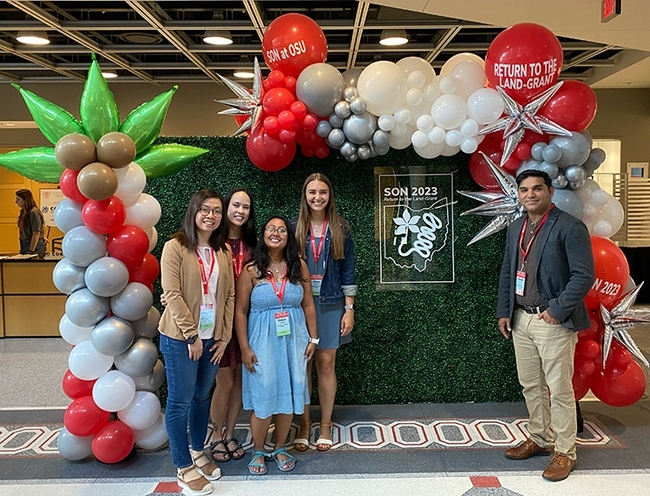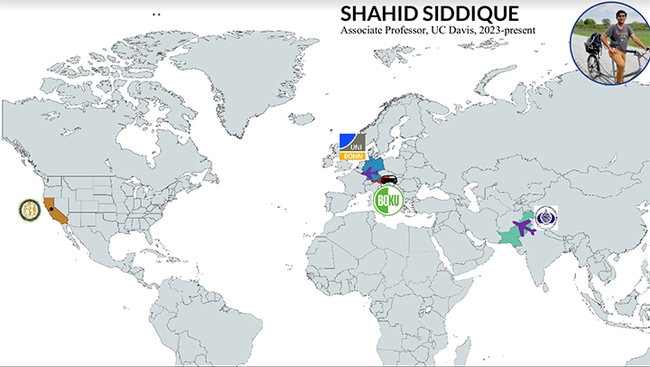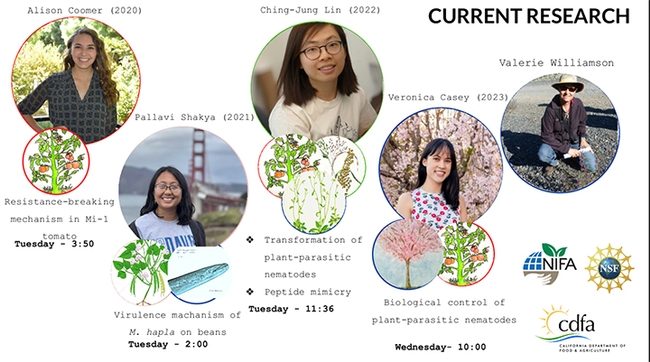- Author: Kathy Keatley Garvey
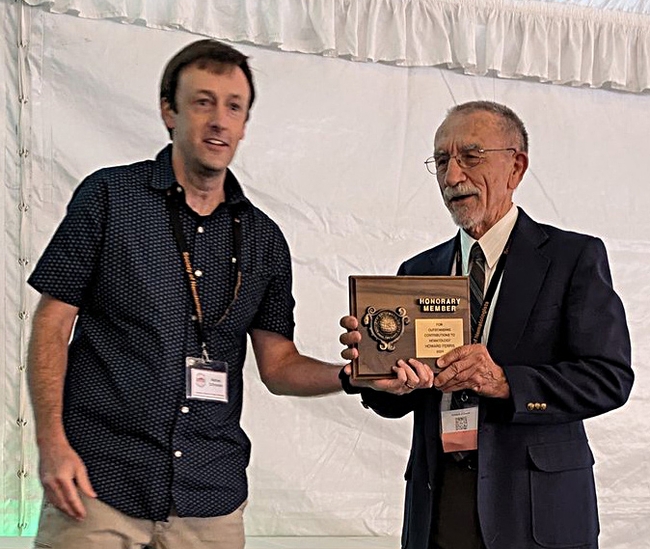
UC Davis Distinguished Professor Emeritus Howard Ferris can.
Internationally recognized for his “exceptional, wide-ranging and unparalleled contributions to nematology” over a 64-year career, Ferris is a newly elected Honorary Member of the Society of Nematologists (SON), the international organization's highest award.
Ferris received the well-deserved award at SON's 63rd annual conference, held in Park City, Utah.
“Dr. Ferris has devoted most of his adult life to the field of nematology,” according to the SON statement read at the awards ceremony. “Similar to the ecological concepts that are central to much of his work, his research record of over 200 peer-reviewed publications has created a web of connections that touch a huge number of nematologists across the world.”
The award, first given in 1968, is an honor achieved by only 2 percent of the membership. Ferris, who served on the UC Davis faculty for 36 years, is the 36th nematologist and the third UC Davis faculty member to receive the honor. SON awarded UC Davis professor Merlin Allen (1912-1974) the honor in 1970, and Dewey Raski (1917-2014) in 1988.
"Howard's contributions and dedication to the discipline of nematology are remarkable in their impact,” said UC Davis Distinguished Professor of Nematology Steve Nadler, former chair of the Department of Entomology and Nematology, and a member of the nominating team.
UC Davis Distinguished Professor Emeritus of Entomology Frank Zalom of the Department of Entomology and Nematology and director of the UC Statewide Integrated Pest Management Program (UC IPM) for 16 years, and a past president and Honorary Member of the Entomological Society of America, said Ferris is “perhaps the premier IPM research nematologist of our time.”
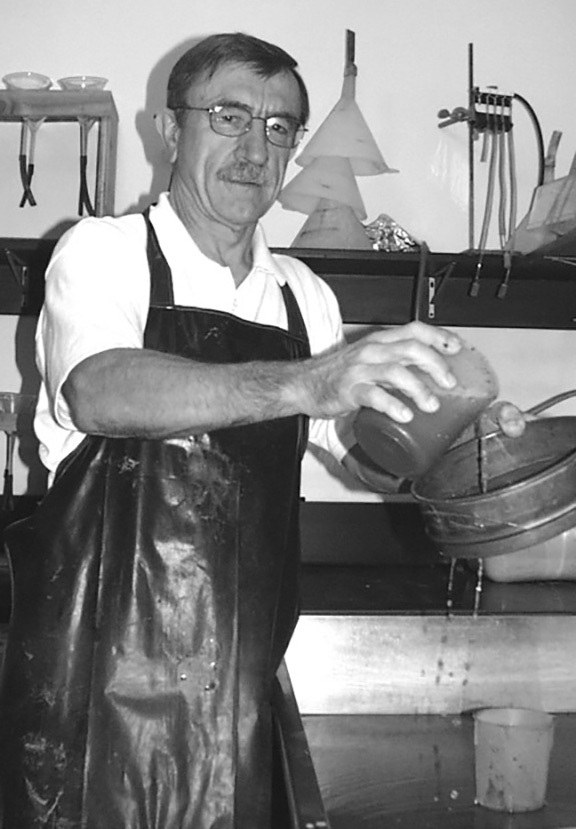
He developed and continues to maintain Nemaplex and Nemabase, “two of the most important online nematology resources available,” wrote the trio of nominators, Inga Zasada, USDA-ARS research plant pathologist, Oregon State University; Professor Larry Duncan, University of Florida; and Nadler. “It is unlikely that there is a nematologist in the world that hasn't used the online resources that Howard created.”
A curious student or an established nematologist who has forgotten something can find what they need in Nemaplex, which covers all things nematode including taxonomy, methodologies, biology, ecology, management,” the nominators wrote, adding that it is a “virtual encyclopedia of nematodes…There are also online tools for selecting cover crops and making economic threshold decisions.”
Nematology Defined. Ferris defines nematology as "Unsegmented roundworms; they inhabit freshwater, marine and soil environments, in fact almost any environment that provides sources of carbon and water. Many are free-living, feeding on microbes and on small animals and plants and so contributing to critical ecosystem services such as nutrient cycling and regulation of communities," Ferris says. "Others are important parasites of plants and animals, including humans. Estimates, although difficult to substantiate, are that 80 percent (4 out of 5) multicellular animals on the planet are nematodes. That is numbers of individuals, not numbers of species.”
Ferris launched Nemaplex in 1987, and since his “retirement,” devotes at least three days each week to developing it and associated databases. The online resource covers the biology, ecology, and management of plant and soil nematodes.
Ferris began his career in nematology as a research scientist for the Tobacco Research Board of Zimbabwe, and then obtained his bachelor's degree in botany and zoology in 1964 from the University of London; his nematology diploma in 1965 from the State Agricultural University, Wageningen, Netherlands; his master's degree in zoology in 1968 from the University of London; and his doctorate in plant pathology in 1972 from North Carolina State University.
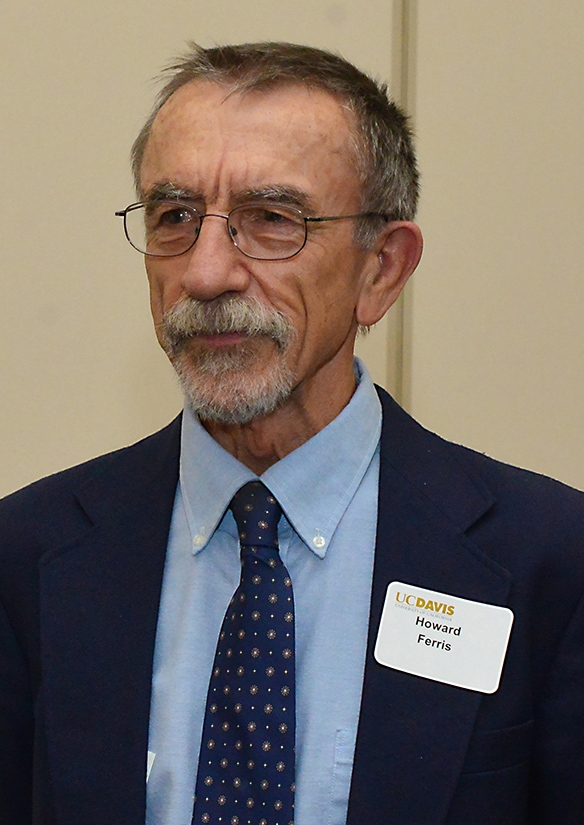
Born in England, Howard emigrated with his family to South Africa in 1946 and to Zimbabwe (then Rhodesia) in “about 1950.” His family moved to New Zealand six years later, then returned to Zimbabwe in 1958. He finished high school there in 1960.
His first peer-reviewed publication? In 1969. Since then, he's published 221 additional peer-reviewed papers,” his nominators wrote. “More than 30 of his publications have received over 100 citations."
Ferris was elected a Fellow of SON in 1995, served as an associate editor of the Journal of Nematology in the 1980s, and organized SON's 28th annual meeting at Davis in 1989, and SON's 38th annual meeting in Monterey in 1999. He was selected a UC Davis Distinguished Professor in 2012. His other honors include the 1984 Ciba-Geigy Recognition Award for Excellence, presented at the First International Congress of Nematology, Guelph, Ontario, Canada; and the 1983 Dimock Lecture at Cornell University.
He has keynoted symposia in the United States, Scotland, Australia, Brazil, The Netherlands and South Africa, and delivered invited lectures in Belgium, Costa Rica, the United Kingdom, and Spain and Mexico, among others. In addition, he has presented international short courses on nematode identification and soil ecology twice in Costa Rica, and also in Nicaragua and Mexico.
“I am honored to have been associated with graduate students, postdoctoral fellows and visiting scientists who have enriched my career and have gone on to be very successful and productive in their own careers as researchers, teachers and leaders in various fields of endeavor,” Ferris said.
What does he do in his leisure time?
“I've been a lifelong-- but very slow--runner which would now be better described as a shuffler,” he joked. In fact, he's run the Comrades Marathon in South Africa several times, and "a few 50 milers in California"--the California International Marathon 20 plus times; and the Western States 100.
He and his wife, Cynthia Hayes, a retired adjunct professor of criminal justice at Sacramento State University and a retired private investigator, reside in Shingle Springs. His goals? “Stay happy and healthy, continue to enjoy UC Davis and to continue to develop Nemaplex!
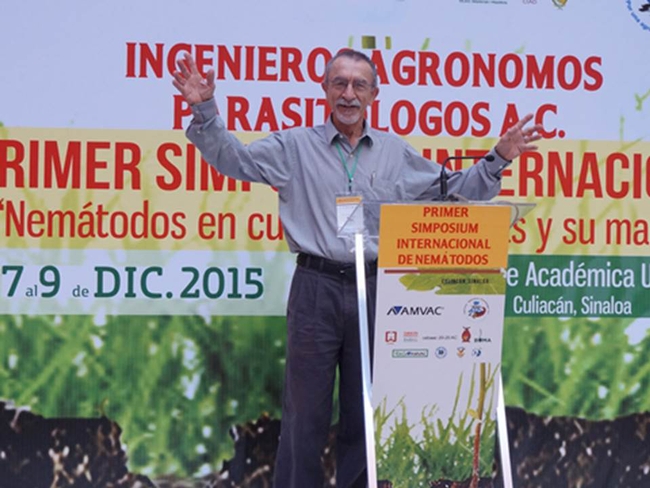
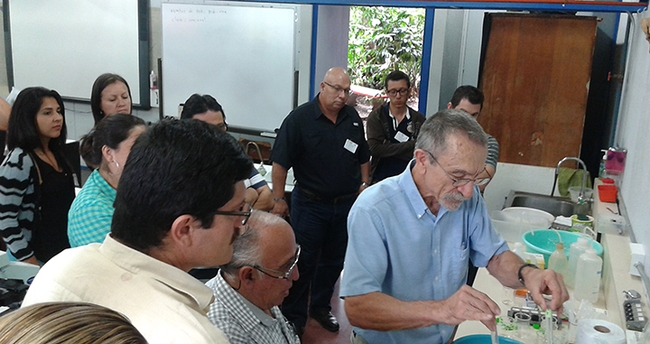
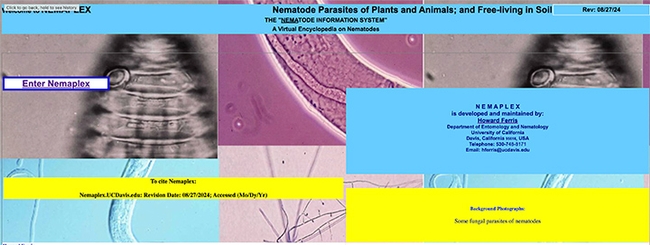
- Author: Kathy Keatley Garvey
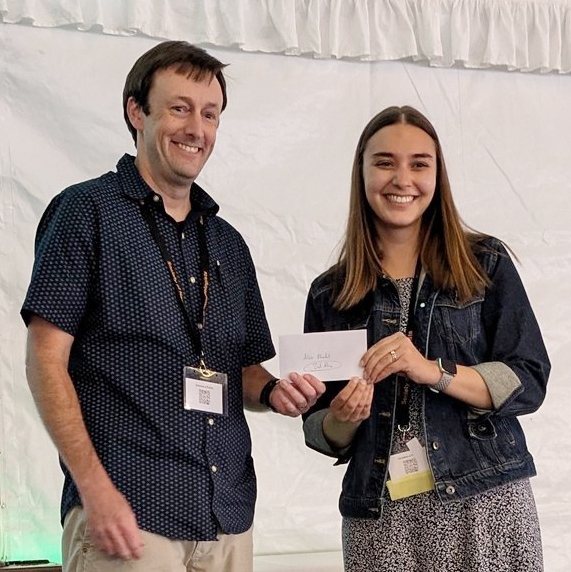
Two UC Davis nematology doctoral students were invited to give research presentations at the international Society of Nematologists' conference in Park City, Utah and they excelled.
Meet the two young women: Alison Blundell, a doctoral candidate who was invited to compete in a 12-minute student oral competition to discuss her research on root-knot nematodes, and doctoral student Veronica Casey, invited to share her research on "Pathogenic Hitchhikers."
Their major professor, Shahid Siddique, encourages his students to participate in the Society of Nematologists (SON), an international organization that advances the science of nematology in both its fundamental and economic aspects.
Blundell, who anticipates receiving her doctorate in 2026, won second place in the international competition with her presentation, “Overcoming Resistance: Unraveling the Mechanisms Behind Root-Knot Nematode Evasion of Tomato Mi-Gene.” She received a $250 prize.
Blundell researches plant-parasitic nematodes specifically root-knot nematodes, and their molecular mechanism to defend against plant immune systems. In her abstract, she wrote: "Root-knot nematodes (RKNs) are among the most devastating pathogens of crops, causing substantial yield and economic losses worldwide. These parasitic organisms can infect over a hundred different plant species and can evade plant defense mechanisms by secreting a concoction of effectors. For decades, the Mi-1 resistance gene has been effective in detecting and inhibiting RKNs in tomatoes. However, the underlying mechanisms by which Mi-1 detects these pathogens remain largely unknown. In recent years, resistance-breaking populations have emerged in both greenhouse and field settings, posing a threat to the potency and effectiveness of the Mi-1 gene and, consequently, the tomato industry. "
"We used two strains of M. javanica, one strain VW4, which is recognized by Mi-1, and another strain, VW5, which was selected from VW4 and can overcome resistance mediated by Mi-1," Blundell explained. "Utilizing the newly constructed reference genome for M. javanica (VW4), we compared genomes of VW4 and VW5 and identified an approximately 50 kb region that is present in VW4 but missing in VW5. This missing region contains seven protein-coding genes, three of which encode putative effectors and are currently being tested as potential avirulence genes for Mi-1."
"In addition, we have conducted a series of infection assays on different host plants lacking Mi-1, and the results revealed a significantly lower egg count in VW5 when compared to VW4. We plan to expand these assays by testing additional M. javanica resistance-breaking strains collected from fields all over California to determine if this trade-off is consistent across other strains. Overall, our results suggest that although VW5 can overcome Mi-1, there is a trade-off in the form of compromised reproduction. This research helps to better understand the mechanism and components of Mi-1 and develop strategies for addressing resistance-breaking populations."
Pathogenic Hitchhikers
Doctoral student Veronica Casey delivered her invited presentation on “Pathogenic Hitchhikers: Investigating the Synergy of Bacteria and Nematodes on Plant Health.”
a"In the vast scope of soil ecology, plant-parasitic nematodes can forge alliances with other microbial adversaries, such as the disease complex formed between nematodes and bacterial wilt-causing Ralstonia spp.," Casey wrote in her abstract. "These disease complexes exacerbate disease symptoms and yield losses. Plant-parasitic nematodes are microscopic roundworms that cause approximately $100 billion in yield loss a year, and most of the damage is attributed to root-knot nematodes (RKNs; Meloidogyne spp.). Bacterial wilt is caused by multiple Ralstonia species, namely Ralstonia pseudosolanacearum, R. solanacearum, and R. sygzii that enter the plant's roots to colonize its vascular system. Prior to Ralstonia infection, RKN infection may facilitate bacterial disease by increasing access to the vascular tissue."
"However, little research has been conducted to elucidate the molecular details of this interaction," Casey pointed out. "Previous reports of RKN and Ralstonia spp. in the field hypothesized that the infection was due to root wounding and physiological changes. In this study, I will determine the nature of the interaction between Ralstonia and nematodes at both ecological and molecular levels. This research project will explore the hypotheses that 1) Ralstonia adheres to the cuticle of nematodes using specialized appendages called pili and 2) de novo xylem formation in the galls increases Ralstonia transport into the plant. A common strategy for preventing nematode infection is by using resistant plant cultivars."
"However, resistance-breaking nematode populations have arisen and we plan to utilize resistance-breaking nematodes, which are most likely to interact with bacterial wilt in the field," Casey noted. "This presentation will report on the attachment and greenhouse experimental results of the RKN-Ralstonia complex. The escalation of climate change is leading to increased instances of pathogenicity; therefore, it is crucial to uncover disease complexes which can have monumental consequences on food security. A meticulous study into the nematode and Ralstonia disease complex will support the management of these damaging pathogens across the world."
Blundell and Siddique also delivered invited presentations in the illustration workshop. Blundell gave her presentation on "Become an Illustrator Mender Simply by Using BioRender," and Siddique, "Doodle Your Data: Adobe Illustrator for Nematodes."
Other lab mates from the Siddique lab also participated in the SON meeting. (See news story). In the ecology session, doctoral candidate Chris Pagan participated from the UC Davis lab of distinguished professor Steve Nadler, former chair of the Department of Entomology and Nematology. Pagan's presentation: "Nematode Community Structure in the Rhizopsheres of Southern California Creosote (Larrea trientata).”
Of note, Blundell and Casey were among the four graduate students from the Siddique lab who received travel awards. Blundell won a Corteva award and Casey, a Certis award. Also receiving travel awards wer Ching-Jung Lin, a Bayer CropScience award and Romnick Latina, a N. A. Cobb Foundation award.
Honorary Member. At the 2024 conference, UC Davis distinguished professor emeritus Howard Ferris was selected a Honorary Member, the highest award that SON offers. (Feature story pending; wait 'til you hear his exciting life story!)
UC Davis nematologists are already looking forward to the next annual meeting: July 13-17 in Victoria, British Columbia, Canada. Meanwhile, you can chat one-on-one with them at the annual UC Davis Biodiversity Museum Day, usually held in February on the UC Davis campus. It traditionally featuring a dozen or so UC Davis museums. Student nematologists are spotlighted on the current website.
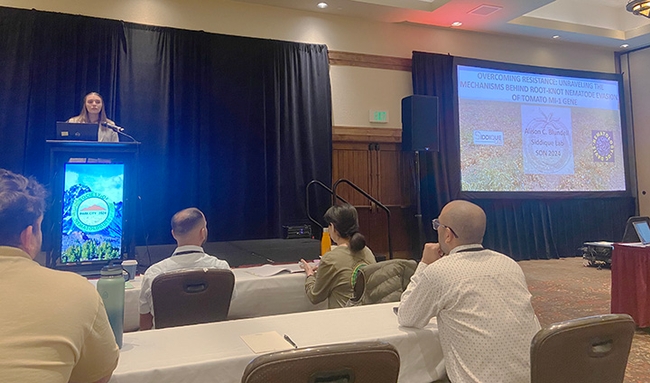
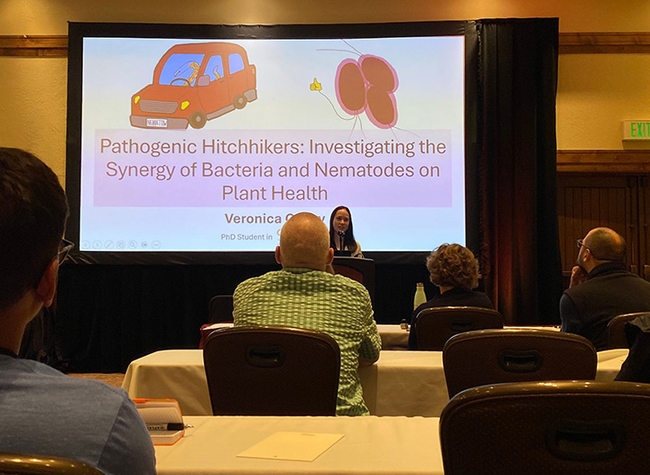
- Author: Kathy Keatley Garvey
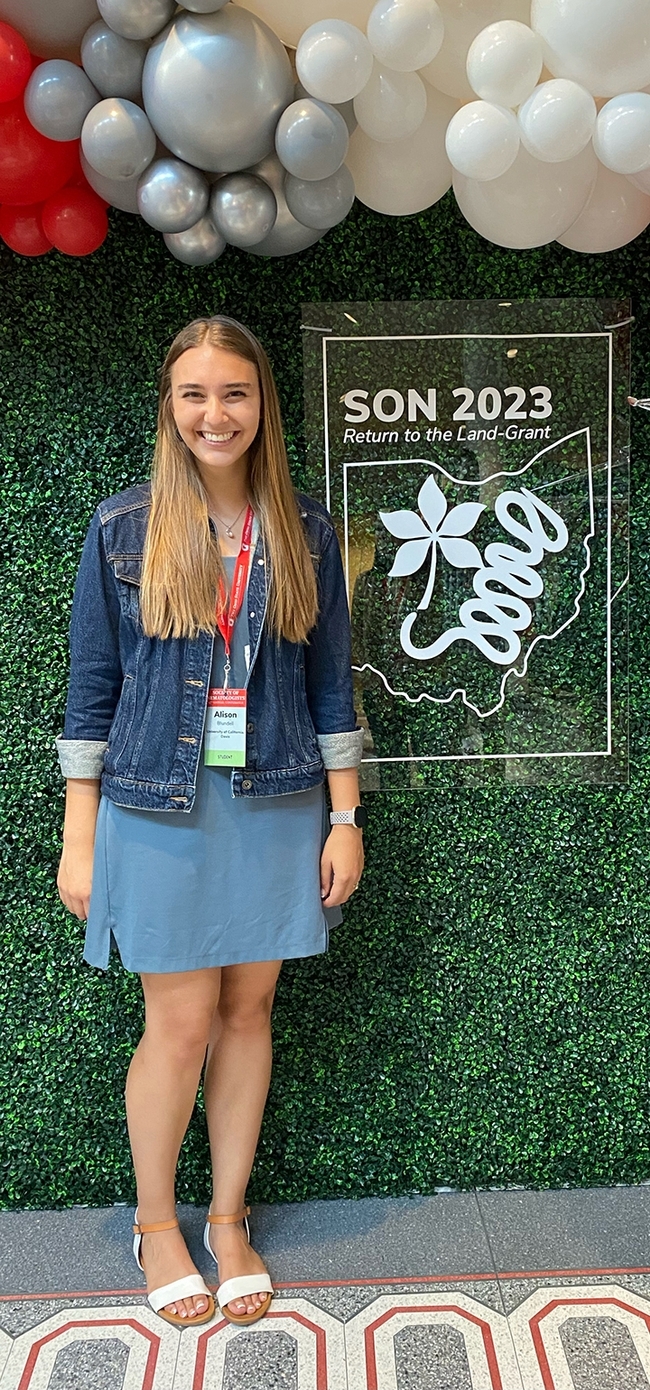
- Alison Coomer Blundell, who will be a fourth-year doctoral candidate in Plant Pathology this fall, won first place in the three-minute student competition with her presentation on “Trade Offs Between Resistance Breaking and Fitness Cost in Root-Knot Nematodes.” She received a $250 award and a plaque.
- Ching-Jung Lin, who will be a fourth-year doctoral student this fall, won second place in the 12-minute category with her presentation on "Elucidating the Role of MigPSY Peptides in Interactions Between Plants and Root-Knot Nematodes." She received a $250 prize.
- The six-member Siddique lab team, "Meloidogyne Gang Gang," which included Blundell, Lin, third-year doctoral student Pallavi Shakya, and second-year doctoral student Veronica Casey, tied for second place in the Cobb Bowl, a jeopardy-like competition that can include both students and postdoctoral fellows on the teams.
The University of Idaho team, one of six teams competing, won the Cobb Bowl. The study material is based on six decks of nematode trading cards created by Jon Eisenback, professor in Virginia Tech's School of Plant and Environmental Sciences. He also hosted the game as "SmartAlex EisenTrebeck." He asked questions in the form of an answer, such as:
- Question: "The Guava root-knot nematode."
Answer: "Meloidogyne enterolobii" - Question: "First report of root-knot nematodes."
Answer:"Who is Miles Joseph Berkeley?"
"The most difficult question, said team member Veronica Casey was: "The color of the first edition of the Journal of Nematology."
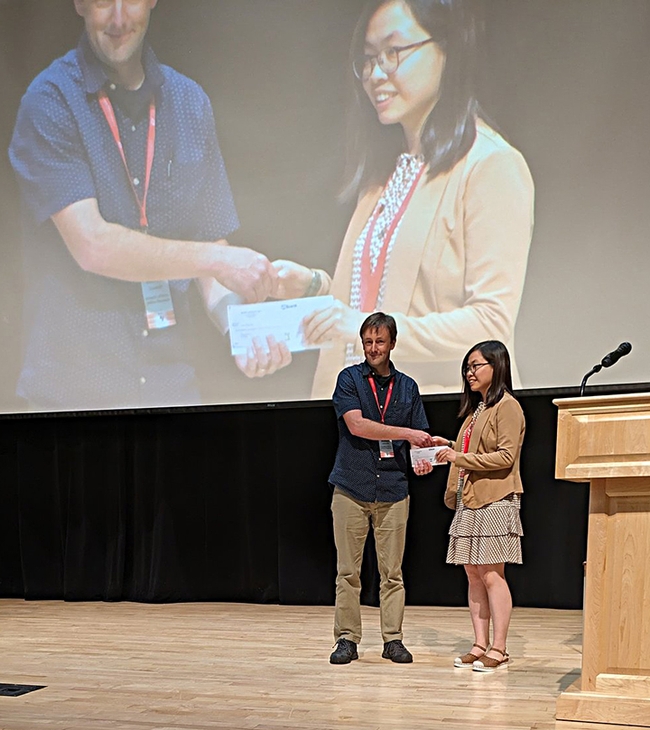
Also at the SON meeting, Siddique participated in a session titled "Nematology Faces of the Future." In his five-minute self-introduction, he displayed a map showing how far he has traveled. A native of Multan, Pakistan, he received two degrees in Multan: his bachelor of science degree from the Government College Bosan Road in 2001 and his master's degree in botany from the Bahauddin Zakariya University in 2004. Then it was off to Vienna, Austria to receive his doctorate in 2009 in agriculture and biotechnology from the University of Natural Resources and Life Sciences. After serving as a research group leader for several years at the University of Bonn, Germany, he joined the UC Davis Department of Entomology and Nematology faculty in 2019 as an assistant professor and advanced to associate professor this year.
"Plant-parasitic nematodes are destructive pests causing losses of billions of dollars annually," Siddique says on his website. "Economic, health, and environmental considerations make natural host plant resistance a preferred strategy for nematode control, but there are limitations to this approach. In many cases, the resistance conferred by resistance genes is partial, and some of the nematodes are able to survive. Similarly, nematode resistance genes are often effective against only one or a few species, whereas plants are exposed to several pathogens in the field. Another concern is the emergence of pathotypes that can overcome resistance. In view of all these limitations, it is important to identify additional mechanisms and tools that can be used to develop novel and sustainable approaches to the management of nematodes."
The Siddique lab focuses its research "on basic as well as applied aspects of interaction between parasitic nematodes and their host plants. The long-term object of our research is not only to enhance our understanding of molecular aspects of plant–nematode interaction but also to use this knowledge to provide new resources for reducing the impact of nematodes on crop plants in California."
